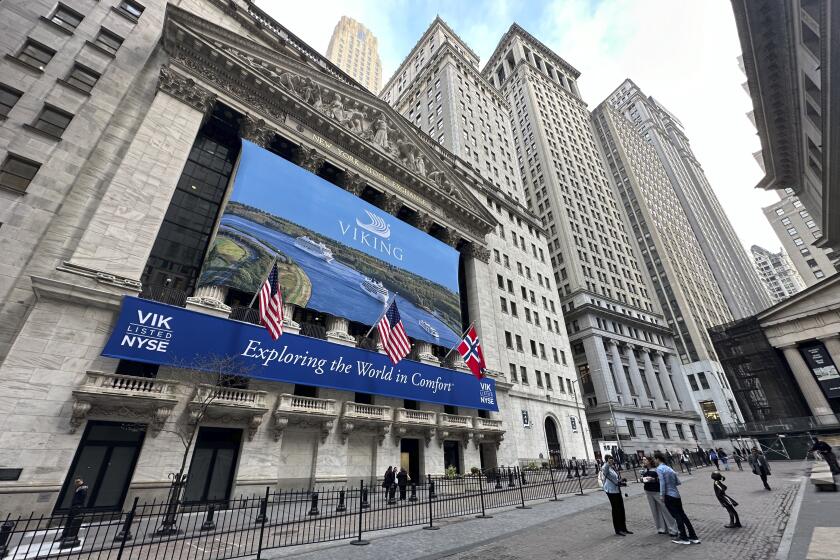Smog Fighters May Make Builders Pay
Convinced that sprawl begets smog, Central Valley air quality officials are expected today to become the first regulators in the nation to force builders to pay air pollution fees for new development.
Builders would pay less if their new homes, shopping centers and office complexes were designed in ways that limited automobile use -- by locating banks and dry cleaners closer to houses, for example, or linking bicycle trails and walking paths to schools and work centers.
The developers could avoid the fees entirely if their projects were environmentally friendly enough.
The idea is to prod builders to cut down on traffic in an area where huge growth, and the cars that come with it, have combined with factory farming to create some of America’s dirtiest air.
The proposal for the San Joaquin Valley, the southern part of the Central Valley, is being closely watched by regulators around the country. It pits the building industry, which loathes the idea and fears that it may spread, against farm groups, the valley’s other major industry.
Builders and some advocates for low-cost housing say the fees will raise prices. Agriculture industry leaders fear that if developers are not required to help clean the region’s air, farmers will bear the entire, costly burden.
The San Joaquin Valley has the highest asthma rates in California and now rivals the Los Angeles Basin for the nation’s worst air quality, according to the health standards set by the U.S. Environmental Protection Agency.
Pollution from farms is a major factor in the region’s air problems. Regulators have recently targeted farm emissions -- including cow flatulence and wine vapors -- to reduce smog.
But overall, motor vehicle exhaust is the valley’s largest source of smog and soot. That pollution is expected to get worse as the region, home to 3.7 million people, doubles in population over the next four decades.
The table-flat, 400-mile-long Central Valley has become a popular real estate destination in the last 20 years as high housing prices in coastal regions have driven thousands inland in search of bigger, cheaper homes.
The result, particularly in the San Joaquin Valley, has been a seemingly never-ending expanse of tract homes near formerly agricultural towns such as Tracy, often populated by people who commute two hours every morning to jobs in the San Francisco Bay Area.
“By the end of this decade, our population is set to increase by 24% and vehicle miles traveled are going to increase 27%, and there is no end in sight,” said Tom Jordan, special projects administrator of the San Joaquin Valley Air Pollution Control District.
“If we are ever going to get a handle on our air pollution problem, we must grapple with this,” he said.
The attempt to link sprawl to air pollution has triggered legal threats from the building industry. Developers fear that similar requirements could eventually be adopted throughout California.
Builders beat back a similar idea in the Los Angeles area in the 1990s.
“We’re opposed to the concept of regulating indirect sources” of air pollution, said Bart Doyle, an attorney for the California Building Industry Assn., which represents more than 6,000 developers, contractors, architects and engineers.
“There are no rules like this anywhere in the country,” Doyle said, “and we see this as a way for the air district to raise money for other air pollution programs that have nothing to do with homes.”
Builders and real estate organizations have mounted a campaign -- titled “Stop the Air Board Tax: We’ll All Pay!” -- to defeat the regulation.
The group, which also includes some local elected officials and chambers of commerce, argues that the requirements and fees will cost Central Valley developers $670 million over five years, raising home prices and shutting low-income buyers out of the market.
But farm industry spokesmen say the time has come for builders to pitch in.
“The ag industry, the oil industry, the food processors, the paint shops, the laundromats -- everybody is doing their part” to reduce air pollution, said Manuel Cunha, president of the Nisei Farmers League, which represents about 1,000 growers.
“If the building industry doesn’t do its part,” he said, “someone else is going to have to pick that up -- and ag isn’t going to pick that up, that’s for damn sure.”
Environmentalists are encouraging air quality officials to brush aside the building industry’s complaints, saying it’s about time someone in California held developers accountable for the consequences of sprawl.
“Houses built at the periphery of town are indirect sources of pollutants, because the people that live in them have to drive everywhere they go,” said Arthur Unger, a member of the Sierra Club’s Kern Kaweah chapter, which has struck legal settlements with individual developers that have required the builders to help finance air pollution programs.
“Communities have to be made more walkable,” he said, “and some developers have started to do this. But it’s still not enough.”
Besides making efforts to cut vehicle miles traveled, developers could lower their exposure to fees by cutting air pollution during construction -- for example, by using equipment fueled by alternative fuels, such as natural gas. They could also reduce their fees by building more energy-efficient structures.
The California Department of Housing and Community Development has come in on the side of the developers, complaining that the proposed regulation could harm affordable-housing projects. The agency has also questioned whether air quality officials have the authority to impose fees on new developments. Some cities have raised similar criticisms, arguing that the regulation would erode local control over development.
Air quality officials maintain that opponents have exaggerated the costs of the rule. At most, they estimate that average home prices would go up $1,770 by 2008 if developers made no changes to reduce fees. They say such increases would not affect affordability.
But Nathan Magsig, mayor of Clovis, near Fresno, says that even a small extra cost is too much. Magsig is also executive director of the Coalition for Urban Renewal Excellence, a nonprofit group that builds housing for low- and moderate-income families.
“A lot of people say that these fees won’t be that much money -- a couple of hundred dollars per new house,” he said. “My response is that I deal with buyers that are already barely able to qualify for a loan. Any additional fee knocks some marginal buyers out.”
Air quality officials say they have the power to regulate indirect emissions from development. They contend they are not creating new permit requirements that developers must meet, but merely demanding compensation for building plans that cause pollution.
“We don’t interfere at all in land-use decisions,” Jordan said. If city officials “want to build sprawling subdivisions, they can do so, but the projects will pay a bigger fee.”
*
(BEGIN TEXT OF INFOBOX)
Pay to pollute
Central Valley air quality officials are set to impose fees on developers who don’t try to reduce air pollution when they build new projects.
Some things builders could do to reduce their pollution fees:
* Locate such facilities as day care centers, restaurants, banks or ATMs, dry cleaners and entertainment and recreation facilities on-site.
* Reduce parking availability.
* Charge parking fees to single-occupant vehicles.
* Provide “traffic calming” modifications to roads, such as narrower streets and speed bumps to reduce vehicle speeds and encourage pedestrian and bicycle travel.
* Build safe and convenient sidewalks and paths, including pedestrian facilities such as overpasses and shaded pathways.
* Install efficient appliances, such as water heaters, cooking equipment, refrigerators and furnaces.
* Improve the thermal efficiency of buildings by using automated temperature controls or occupant sensors.
* Install electric vehicle recharging stations in residential garages and parking lots.
* Build new homes with internal cabling that allows telecommuting.
Source: San Joaquin Valley Air Pollution Control District






